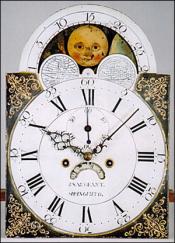Jacob Sargeant of Springfield, Massachusetts. Tall clock. 26198.
This is a nice country-cased example. The case stands on wonderfully formed ogee bracket feet. Fluted quarter columns are inset into the waist section. They terminate in brass quarter capitals and center the nicely shaped waist door. The bonnet columns are also fluted and terminate in brass capitals. An interesting fretwork pattern, three fluted finial plinths, and three brass ball and spiked finials surmount the top of the bonnet. The bonnet door is arched in form and opens to the painted dial signed by the Maker. The arch of the dial features a moon phase mechanism that tracts the lunar calendar. The movement is brass eight-day duration and of good quality.
This clock was made circa 1790.
The height of this example to the top of the center finial is 7 feet 11 inches tall.
Inventory number 26198.
Jacob Sargeant was born in Mansfield, Connecticut, on February 28, 1761. He was the son of Samuel and Hannah (Baldwin) Sargeant. It is recorded that he trained Nathan Storrs in 1781. We now speculate that he may have been trained as a clockmaker by Peregrine White of Woodstock, Connecticut, due to the similarities of movement construction found in examples by both clockmakers. Jacob also worked as a gold and silversmith. Jacob worked in Mansfield from 1784 through 1789 as a goldsmith and silversmith. He advertised in The Connecticut Gazette and the Universal Intelligencer (Mansfield Center CT) on January 11, 1784, ". . . shop in Mansfield makes clocks and watches, gold and silversmith work." On January 30, 1785, Jacob married Olive Paine of Canterbury, Connecticut, in Mansfield Center, CT. In 1790, he trained his brother Thomas Sargeant (1773-1834). In 1790, Jacob moved to Springfield, Massachusetts, and advertised in the Hampshire Chronicle (Springfield, MA) 1790 as a gold- and silversmith. Here, he continued to make clocks and sell jewelry and employed his younger brother Thomas as an apprentice. He also trained Shubael Storrs in 1790 and Charles Brewer in 1791. In October 1795, he advertised in the "Courant," a Hartford newspaper, that he had moved or "Established his business at the sign of the Golden Watch a few rods South of the State House in Hartford. "By 1800, Sargeant had a retail business which was one of the largest in Hartford; he sold his own silver, the silver of other makers, guns, and clocks. While in Hartford, he trained Joseph Church in 1816 and Walter Ward Hart in 1820. He remained in Hartford until he died in 1843. Jacob Sargeant's shop sign is now in the Connecticut Historical Society collection.
We have seen and owned a fair number of tall clocks made by Jacob Sargeant. The earliest examples feature engraved brass dials finished with a silver wash. One such example, which is signed Hartford, features a musical movement. It is a three-train clock and plays one of six tunes on the hour. The four spandrel areas are decorated with depictions of the four seasons. This dial is thought to have been engraved by Richard Brunton, a well-known maker of dials and bookplates and, among other talents, a counterfeiter of currency. The case is cherry and is attributed to Aaron Chapin of East Windsor. This case exhibits the Hartford / Norwich form. A second example also features an engraved dial. That dial is silver and features a rocking ship in the arch. The four spandrel areas are skillfully engraved depictions of the four seasons. This case is also cherry. It features an applied swan's neck pediment, which is pierced. (Chapin Case?) The majority of the other examples found have been painted dial clocks.












